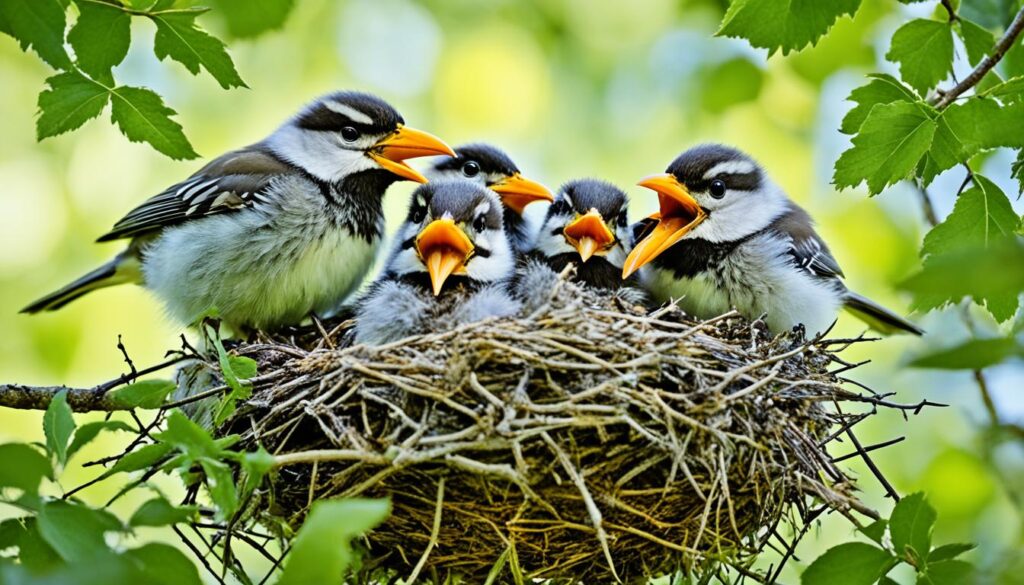Did you know orphaned baby birds have a survival chance as low as 50%? This number shows the huge need for right care and food. As professionals, we know how vital this is. We’ll share the best ways to feed these tiny birds. This guide will help them grow strong and healthy.
Key Takeaways
- Orphaned baby birds require specialized care and feeding to improve their chances of survival.
- Different bird species have varying dietary needs, necessitating proper identification to provide the appropriate food.
- Hand-feeding baby birds is a significant commitment that requires time, patience, and commitment.
- Consulting with bird breeders, avian veterinarians, or rehabilitation centers is recommended for the best outcomes.
- Proper temperature, humidity, and sanitation are crucial for maintaining the health and well-being of baby birds.
Understanding Baby Bird Feeding
Hand-feeding baby birds is quite common when their parents can’t do it. This might happen if their nest gets destroyed or their parents die. It’s also needed if the chicks are orphaned. Hand-feeding is how these little birds get the food and care they need. This helps them survive and become friendly with people, making them less afraid of pets and kids.
Importance of Hand-Feeding Baby Birds
It’s very important to hand-feed baby birds for their health and growth. Without their parents, these chicks need someone to look after them all the time. They need a diet that’s just right for them. Caretakers make sure the birds are healthy, growing well, and in a safe place.
Advantages and Responsibilities of Hand-Feeding
Hand-feeding baby birds has good points but also needs a lot of work. Baby birds rely completely on their caretaker. This involves feeding, cleaning, and making sure they live in a good place. It’s better if someone skilled, like a bird breeder or an expert, takes care of them. If you want to hand-feed a baby bird, talk to a bird expert first.
Here are some things you need to think about with hand-feeding baby birds:
- Time and Commitment: Feeding baby birds by hand is a big time commitment. You might have to feed them every 30 minutes or hour when they’re very young.
- Specialized Diet: They need a special diet. This includes certain foods and hand-feeding formulas.
- Environmental Control: The place they live in must be just right, with the correct humidity and temperature. This is vital for their well-being.
- Potential Challenges: Hand-feeding can be hard and risky. There are dangers like getting food stuck in their crop. But, with care and the right techniques, these risks can be lowered.
Hand-feeding baby birds is a big job but also very rewarding. Only someone with the right knowledge and help should take it on.
When to Start Hand-Feeding
Deciding when to start hand-feeding baby birds is key for their health and growth. Experts often recommend waiting up to three weeks before weaning. This time lets the young ones learn to eat from you without stress.
Baby birds’ crop fullness must be checked before each feeding. It’s best if the crop is never empty. In the first week, they need to eat every two hours, day and night. As they get older, feedings are less frequent. At two to three weeks, they eat every three to four hours.
By five or six weeks, feed them twice daily and introduce solid foods. Baby birds must grow strong before they’re weaned at about 7 to 8 weeks. Their weight should increase every day during this time.
“Leaving the chicks with their parents for as long as possible allows them to receive the necessary care and nutrition from their parents, which is essential for their development.”
The best time to start hand-feeding is at 3 to 4 weeks. This way, they get their parents’ care early on. It’s important to keep an eye on their progress. Adjust the feeding and weaning as needed for a happy, healthy bird.
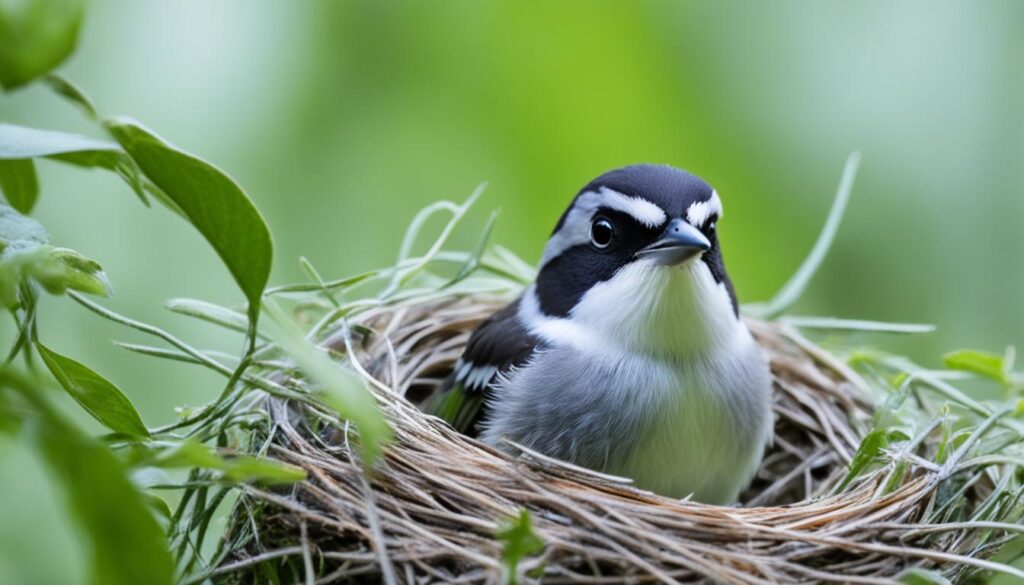
Setting Up a Suitable Environment
It’s very important to keep the right temperature and humidity for baby birds. Newborn birds need high humidity, over 50%, and temperatures between 95°F and 97°F (35°C-36°C). As their feathers grow, baby birds can handle changes in temperature better.
Temperature and Humidity Requirements
You can keep baby birds in different places, like brooders or incubators. It’s good to have thermometers and humidity gauges to check the air. The right temperature and humidity help baby birds stay healthy and grow well.
Brooder Setup and Bedding Materials
The bottom of the brooder should have soft material, like paper towels or hand towels. This keeps the birds safe and clean. Make sure to change the bedding often to prevent problems like splayed legs.
Only use bedding that won’t hurt the birds, like paper towels or hand towels. Others, like sawdust, can cause issues. Setting things up right makes a big difference in the baby birds’ lives.
Choosing the Right Formula
Feeding baby birds the right way is key. Choose one hand-feeding formula and stay with it until the bird is fully weaned. Discuss the diet with a bird expert to give the best nutrition. This will help your baby bird grow well without stomach issues.
Commercial Hand-Feeding Formulas
There are many hand-feeding formulas for baby birds. Brands like Kaytee, Zupreem, and Mazuri are known for their quality. These formulas are made to give baby birds all they need to grow.
Pick a formula based on your bird’s type, age, and diet needs. A professional’s advice is crucial. They can guide you in choosing the best for your feathered friend.
| Formula | Ingredients | Suitability |
|---|---|---|
| Kaytee Exact | Soy, corn, vitamins, and minerals | Suitable for a variety of baby birds, including songbirds and parrots |
| Zupreem | Soy, corn, vitamins, and minerals | Suitable for a variety of baby birds, including songbirds and parrots |
| Mazuri | Soy, corn, vitamins, and minerals | Suitable for a variety of baby birds, including songbirds and parrots |
| Harrison’s | Millet, barley, vitamins, and minerals | Suitable for parrots and other psittacine birds |
Some formulas might have soy and corn, which aren’t good for all birds. Again, talking to an expert is wise. They can help you pick a formula that’s safe and healthy for your bird.
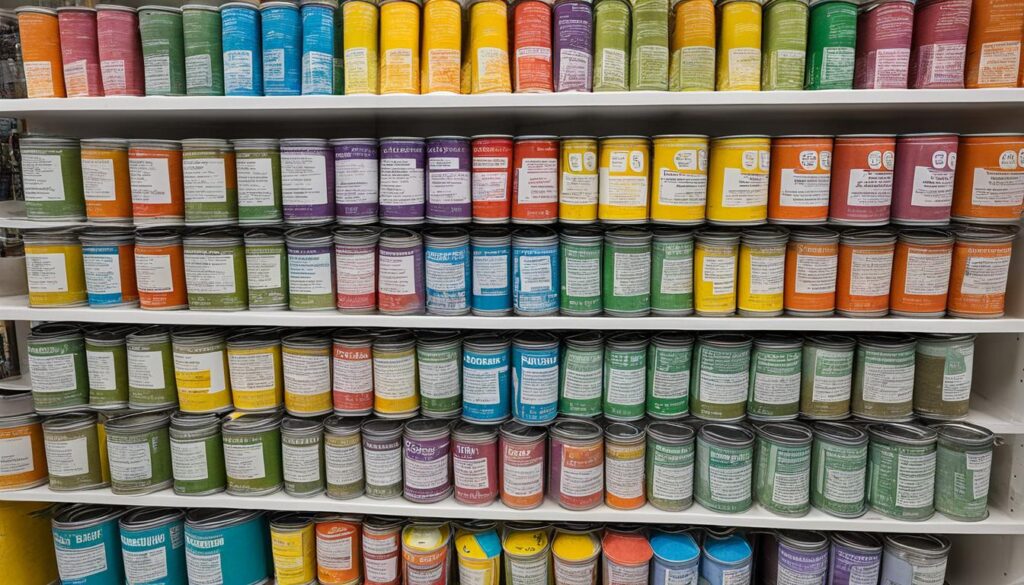
“Choosing the right formula is critical for the health and well-being of your baby bird. Consult with an avian expert to ensure you’re providing the best possible nutrition.”
Preparing and Feeding the Formula
Caring for orphaned baby birds needs careful work. You have to make the formula right and feed it well. This will give them the right nutrients and keep them safe from health issues. Here’s what you need to know about getting the formula ready, keeping it warm, and how to feed the chicks.
Mixing and Temperature Guidelines
Always make fresh formula for each meal. Old formula can grow bad bacteria or yeast. This can harm the birds’ stomachs. Be sure to mix the formula well. You want it all one temperature. Aim for 102°F-106°F. Use a thermometer to check this. Not having the right temperature can hurt the bird’s stomach or slow down digestion.
Feeding Techniques and Tools
For feeding baby birds, use syringes. They help you give the right amount of formula. This means better feeding control and the bird’s growth. Some people use a special spoon for this reason. However, a syringe is better for the exact amount.
Feeding tubes are not a good idea. They can hurt the crop or fall out. This could need surgery. If the bird doesn’t eat well, don’t force it. You might push formula into its breathing tube. This is very dangerous.
“Proper feeding technique is essential to avoid aspiration and crop damage in orphaned baby birds. Syringes provide the most control and accuracy, ensuring the formula reaches the intended destination safely.”
Follow these steps for the formula and feeding tools. This will help the orphaned birds grow well and get healthy. Do your best for them.
preparing hand-feeding formula
Feeding Schedules and Amounts
Finding the right feeding schedule and portion sizes is key for orphaned baby birds. The amount and how often you feed them changes based on age and the formula used.
Age-Based Feeding Frequency
Newly hatched chicks need to eat 6–10 times a day. Feed them every 2-3 hours. Feed them less often as they grow. Chicks with closed eyes eat 5–6 times a day, every 3-4 hours.
After their eyes open, they eat 3–5 times a day, every 5 hours. When their feathers show, feed 2–3 times daily, every 6–12 hours.
Monitoring Weight Gain and Crop Emptying
Weigh the bird daily at the same time. Use a gram scale to watch for any changes. Their weight can change daily, but it should mostly go up. A vet should check any weight loss.
A healthy bird shows hunger and has an empty crop before each feeding. It should also produce droppings regularly. Checking its crop can tell you if it’s eating right.
| Age of Baby Bird | Feeding Frequency |
|---|---|
| Newly Hatched | 6-10 times per day (every 2-3 hours) |
| Eyes Not Yet Open | 5-6 times per day (every 3-4 hours) |
| Eyes Open | 3-5 times per day (every 5 hours) |
| Feathers Growing In | 2-3 times per day (every 6-12 hours) |
Watch the feedings, weight gain, and when their crop empties. This helps ensure they get good nutrition for growth. Keeping detailed notes can catch any problems early and help with their care.
monitoring baby bird weight gain
Weaning Baby Birds
Transitioning a baby bird from a hand-fed formula to self-feeding solid foods is important. It helps the bird to grow and develop their feathers. This process, known as weaning baby birds, needs patience and a gentle touch. It ensures the change goes smoothly.
Transitioning to Solid Foods
Start by offering a mix of solid foods to the baby bird. This can include formulated pellets, fresh fruits, and veggies. Encourage the bird to try new foods by adding variety.
As it starts to eat solid foods, you can cut back on hand-fed formula. Begin with feeding it less during the mid-day meals. The goal is to make the bird more independent.
- Introduce a variety of solid food options, including formulated pellets, fresh fruits, and vegetables.
- Gradually reduce the amount of hand-fed formula as the baby bird starts consuming solid foods on its own.
- Begin by reducing the mid-day feedings, allowing the bird to become more self-reliant.
It’s important to let the baby bird lead in feeding itself. This way, it learns to eat like a wild bird. It prepares them to handle a diet without your help.
“Weaning is a delicate balance between providing support and allowing the bird to become self-sufficient. It’s important to strike the right balance to ensure a smooth and healthy transition.”
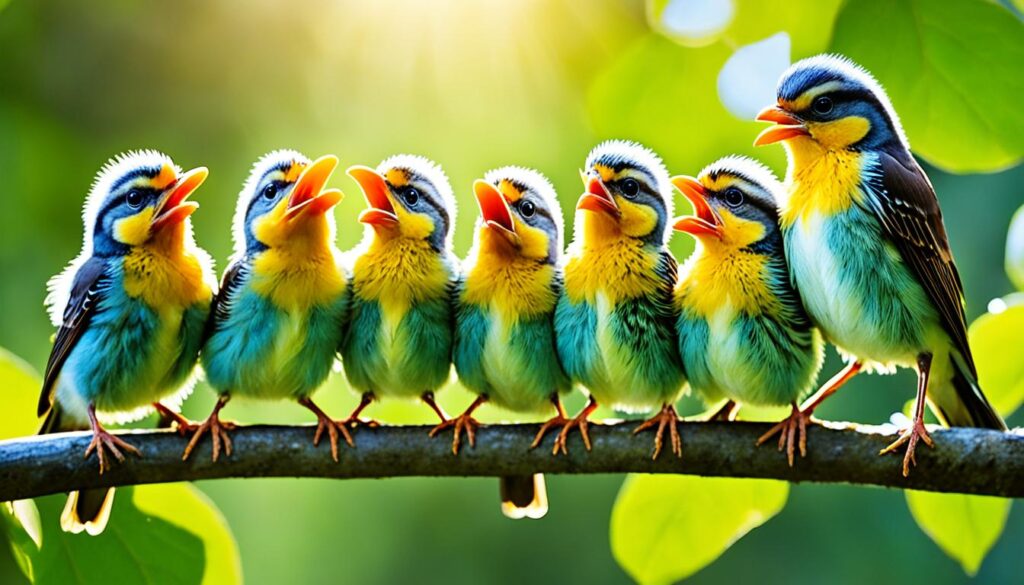
Every bird is different, so the weaning process can change. Keep an eye on things like weight, crop emptying, and overall health. This makes sure the baby bird makes it through weaning successfully.
Disinfection and Sanitation
Looking after baby birds means paying very close attention to keeping things clean. Since they’re so young, their immune systems are not fully grown. This makes them very likely to get sick. It’s vital to keep their living spaces and eating tools disinfected and clean.
The first step in sanitation for baby birds is their living area, called a brooder. This spot needs to be very clean to avoid harmful germs. A special cleaning solution should be used to wipe everything. Then, the area should be left to dry well before the birds go back in.
Don’t forget about the tools you use to feed these little birds, like syringes and spoons. These tools should be cleaned and disinfected thoroughly after each use. It prevents spreading diseases. Also, using a different clean tool for each bird is a smart move to keep them all healthy.
| Disinfection Frequency | Disinfection Practices |
|---|---|
| Brooder: Daily | – Wipe down all surfaces with a disinfectant solution – Allow to air-dry completely before reintroducing birds |
| Feeding Utensils: Between Feedings | – Clean, disinfect, and thoroughly dry all feeding tools – Use separate utensils for each individual bird |
It’s key to keep the baby birds’ home clean and germ-free. By sticking to a regular cleaning routine, you can help avoid sickness. These little ones will grow up in a healthy and happy place.
“Cleanliness is crucial when it comes to caring for baby birds. Neglecting disinfection and sanitation can have devastating consequences for their fragile health.”
Signs of Trouble
Starting the journey of hand-feeding baby birds is a big step. It’s important to keep a close eye out for any warning signs. By watching the chicks well, you can spot health problems early. You can then act fast to help them.
Pay special attention if the birds are chirping too much or seem upset. A lot of noise from a baby bird might mean it’s not feeling well. If a chick seems tired, not eating, or not growing as it should, this is a problem. You’ll need to check it out more closely.
Also, be careful if the birds’ crops seem to not empty quickly. The crop is where a bird’s food goes first. If it’s not working right, there might be a health issue. This kind of problem needs a vet’s help right away.
- Watch for strange positions or stretching of wings and legs.
- Keep an eye out for abnormal or no droppings.
- Be alert if you see skin over the crop getting wet or covered in food.
If you see any health issues, it’s time to get help from a bird vet. A specialist can figure out what’s wrong and how to fix it. This step is key to making sure the chick gets back to full health.
Always be on the lookout for health problems and act fast. Monitoring and quick action are vital for their care. Seek professional help when necessary. This is how you can help these small birds grow strong and healthy.
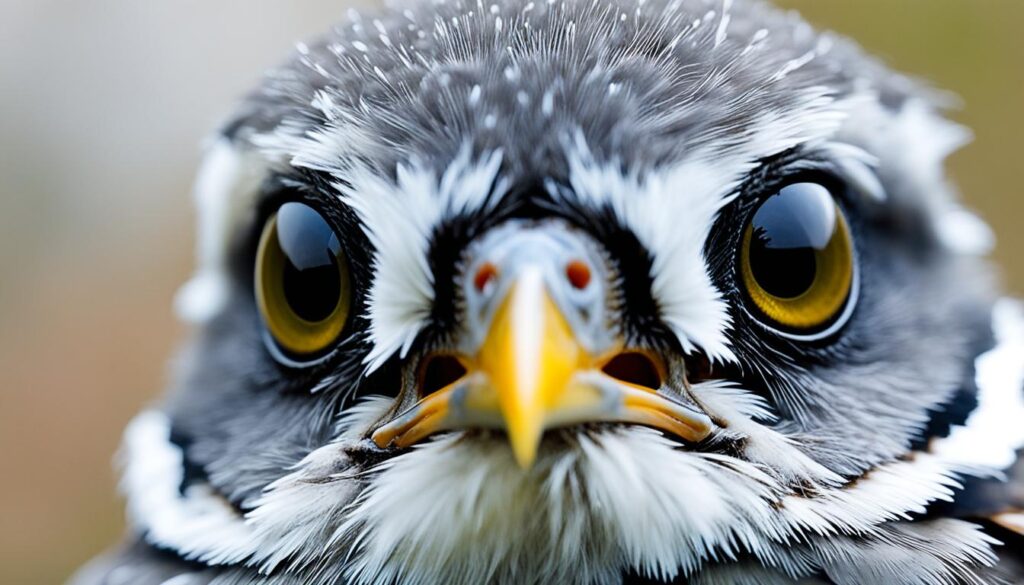
“Caring for baby birds means paying attention and noticing small signs. Spotting illness early can save their lives. It gives them a better chance to grow up strong and healthy.”
what can i feed baby birds
Caring for orphaned baby birds can be both rewarding and challenging. It’s vital to feed them the right way. Hand-feeding formulas act as a baby bird’s main diet. Still, adding safe, natural foods can boost their health and growth.
Safe Food Options for Orphaned Chicks
When caring for orphaned baby birds, opt for foods that are safe and easy to digest. Safe food options include:
- Wax worms/grubs – These insects are high in protein and easy for baby birds to eat. They can be cut into smaller pieces for the tiniest chicks.
- Meal worms – Like wax worms, remove the meal worms’ heads to avoid any harm to the chicks.
For the smallest birds, carefully feed them insect pieces using a tool like a hemostat or toothpick. Older birds can be fed between 4 to 8 insects every 45 minutes to an hour. This is on top of their usual formula.
| Feeding Schedule | Insect Quantity | Frequency |
|---|---|---|
| Infant Birds | 1-4 insects | Every 20 minutes to 30 minutes |
| Juvenile Birds | 4-8 insects | Every 45 minutes to 1 hour |
Adding these insects to their diet, along with hand-feeding formula, is great. It ensures orphaned baby birds get all the necessary nutrients. Remember to introduce these foods slowly and not overdo it in their diet.
“Proper nutrition is crucial for the survival and healthy development of orphaned baby birds. Supplementing their hand-feeding formula with safe, natural food options can make a significant difference in their overall well-being.”
Knowing the right foods and feeding times for baby birds can significantly help them. It increases their chances of getting back to the wild successfully.
supplementing hand-feeding formula
Feeding Baby Doves and Pigeons
Doves and pigeons, also known as columbine birds, need special care in their feeding. They turn their crop into a “milk” organ. This is like what flamingos, penguins, and parrots do. Because of this, cow or goat milk is not good for them. It has too much sugar that their bodies can’t handle well.
Specialized Diet Requirements
A homemade mixture called “MAC Milk” has worked well for people taking care of these birds. It is made from instant oatmeal, soy milk, and eggs. This mix gives the baby birds the right nutrients.
Homemade Formula Recipe
To make the formula, you will need instant oatmeal, unsweetened organic soy milk, and whole eggs.
- Instant oatmeal
- Unsweetened organic soy milk
- Whole eggs
Mix these ingredients and heat them in the microwave. Let the mix cool before you feed it to the birds. Be sure it’s not too hot or cold. You can feed the formula to the birds using a pipette or a catheter.
The formula must be the right temperature, around 89.6°F (32°C). This helps the birds digest the food well. If the temperature is not right, they might get sick.
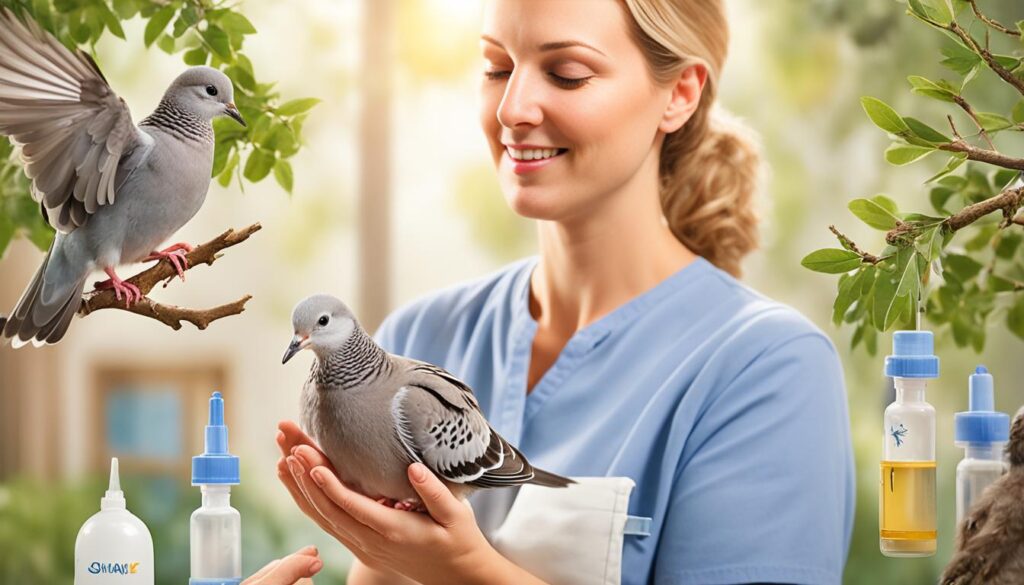
“Doves and pigeons transform their crop into a ‘milk’ producing organ, similar to flamingos, penguins, and parrots.”
In the wild, these birds eat all sorts of foods like grains, seeds, greens, and fruits. Sometimes they have insects and worms too. Due to this natural diet, giving them just seeds may not be enough. It is better to give them a mix of pellets, fresh foods, and a little bit of seed.
Dos and Don’ts of Baby Bird Feeding
Hand-feeding baby birds needs care. Follow these important dos and don’ts. They keep the chicks you’re caring for safe and healthy.
Dos of Baby Bird Feeding
- Keep things clean to stop sickness. Wash all feeding tools well.
- Change your hand positions while feeding. This helps avoid a scissor beak.
- Watch how the bird grows and how fast its crop empties. It tells you if they’re eating enough.
- If the bird looks sick or hurt, get help from a pro wildlife helper.
Don’ts of Baby Bird Feeding
- Don’t press on a bird’s crop, especially if it’s full. It might make them spit up or choke.
- Never try to use a feeding tube if the bird’s head isn’t right. They should look up with their neck back.
- If a feeding device doesn’t slide in easily, don’t push it. You could hurt the bird.
- Never feed a bird not fully awake. They might need water or sugar first.
By sticking to these dos and don’ts, feeding should be safe. This makes sure you don’t make common mistakes and give the birds the best care.
| Safe and Recommended Foods | Foods to Avoid |
|---|---|
|
|
“Feeding baby birds should only be done as an emergency measure, and they should be taken to a bird rescue organization or rehabilitation center as soon as possible.”
Always aim for the best when feeding baby birds. Follow the do’s and don’ts closely and get help if needed. This way, you can take great care of these little, fragile birds.
Seeking Professional Help
This guide gives a full view of feeding baby birds by hand. But it’s key to know that pros, like wildlife rehabilitators, offer the best care for abandoned or hurt chicks.
If you’re unsure about a baby bird’s health or needs, or can’t give the proper care, contact a wildlife rehab center right away.
When to Contact a Wildlife Rehabilitator
Wildlife rehabbers are experts at caring for baby birds. They can check the bird’s health, give it medicine, and make sure it gets the special care it needs. It’s vital to call them in these cases:
- The baby bird seems sick, hurt, or is having trouble breathing
- It can’t stay warm or looks weak and tired
- The parents aren’t feeding it, or they’re missing
- If it’s a baby (no feathers) and it’s on the ground
- If you don’t know its species or how to help it
Trying to take care of a baby bird on your own can sometimes backfire. Taking them to a pro wildlife rehabber is the best call for their well-being.
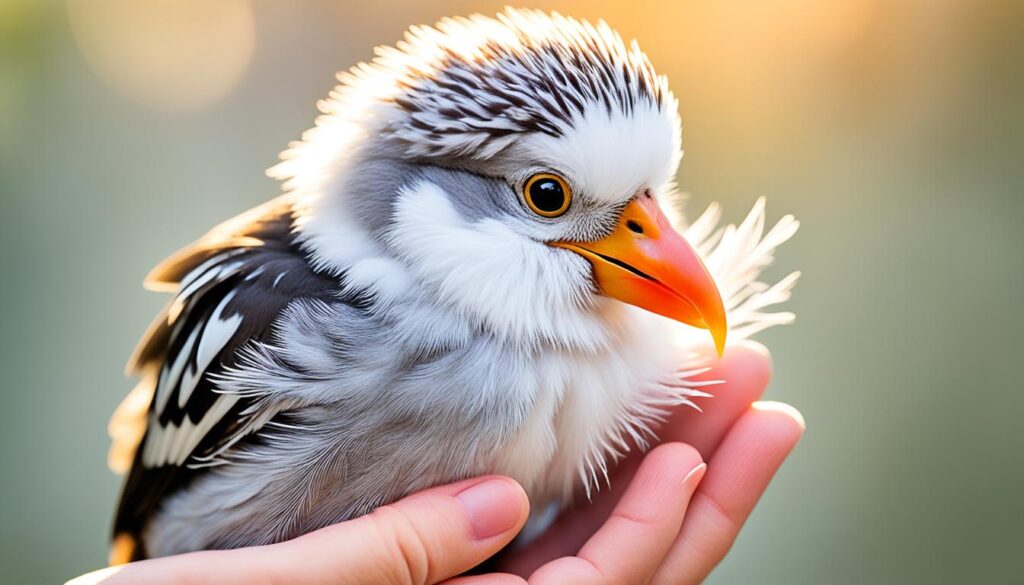
“The best thing you can do for a baby bird is to leave it alone and call a wildlife rehabber. They have the skills, tools, and places to give these needy creatures the right care.”
Getting help from a professional can boost a baby bird’s chances of making it and going free. Always feel free to contact your local wildlife center if you find a baby bird that needs help.
Conclusion
Caring for baby birds, whether orphaned or hurt, is a big task. You need time, knowledge, and a big heart. If you follow the right steps, you can help them well. This means knowing how to feed them, making a safe place, and watching for any issues. Key tips are picking the right food, having a regular feeding plan, and keeping their space clean and warm.
But, it’s key to know that pros can often help these birds better. They have more skills and tools. If you’re not sure how to care for a baby bird, don’t do it alone. Reach out to your local wildlife center. They can advise you or even take the bird in. Their help can make a huge difference for the bird’s future. Plus, it helps them go back to their natural home safely.
Want to know more about helping baby birds? Look online or in your area. There are lots of trusted places you can turn to. Talking to bird vets or wildlife experts is also a great idea. They offer tips and guidance. They can teach you how to meet the needs of various bird types. With the right help, you can make a real difference in a bird’s life.
FAQ
What are the advantages and responsibilities of hand-feeding baby birds?
Hand-raised baby birds become fantastic pets. They’re not afraid of people and understand human behavior. But, caring for them is a big task that needs much time and love. People experienced in bird raising should handle it.
When is the best time to start hand-feeding a baby bird?
Remove a chick from its parents before it can feed itself. Some experts say wait up to three weeks. Hand-feeding is harder when they’re older. Letting them stay with parents as long as possible helps ensure they’re healthy.
What are the temperature and humidity requirements for baby bird enclosures?
Newborn birds need warmth, about 95-97°F, and some humidity. As they grow feathers, they handle temperature changes better. The brooder should be safe with nothing that could harm them.
What type of hand-feeding formula should be used for baby birds?
Many formulas are available for baby birds. Pick one and stick to it until the bird is fully weaned. Talk to a bird expert or vet about the best food for your bird. Changes in diet can cause problems.
How often should baby birds be fed, and how much should they be fed?
Their diet and age determine feeding times and amount. Newly hatched chicks need feeding every 2-3 hours. Older chicks may eat 2-3 times a day. Make sure their weight is good and their crop empties between meals.
When should a baby bird be weaned off the hand-feeding formula?
As birds grow feathers, begin encouraging them to eat on their own. Offer various foods to promote independence. Start skipping some feedings, like the middle of the day, as they start eating solid foods.
What are the signs that a baby bird may be sick or in distress?
Baby birds that are always vocal, tired, are not eating well, or not growing right may be sick. Look for signs like bad posture, odd droppings, or food sticking on skin. If you see these signs, get help from a bird vet.
What are some safe food options for orphaned baby birds?
For tiny birds without parents, use safe insects like wax worms. Big birds can eat mealworms without heads, which should be cut small. This food adds to their diet to keep them healthy.
How do you feed baby doves and pigeons?
Doves and pigeons need a special diet. Make “MAC Milk” from oatmeal, soy milk, and eggs. It should be warm for good digestion.
What are some important dos and don’ts when hand-feeding baby birds?
When hand-feeding, never press the crop or force-feed. Avoid harm like scissor beak by changing sides when you feed a baby bird. Keep everything clean, and only feed birds that are lively and alert.
When should you contact a wildlife rehabilitator for an orphaned or injured baby bird?
If you can’t care for a baby bird or aren’t sure it’s well, call a wildlife center. They’re trained and equipped to help the bird. It’s best for their chance of survival.
